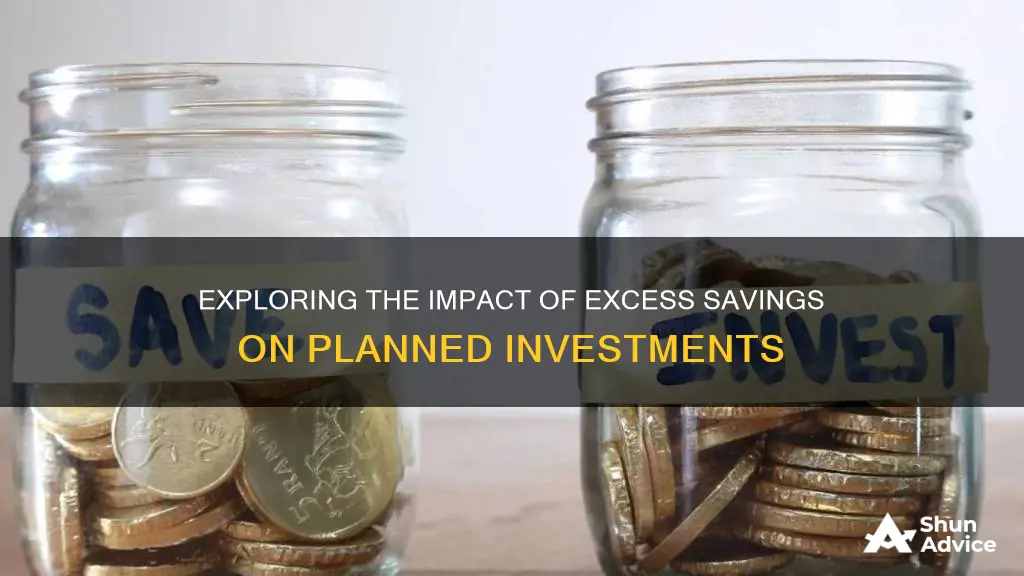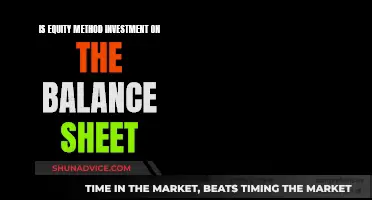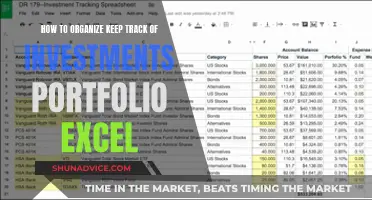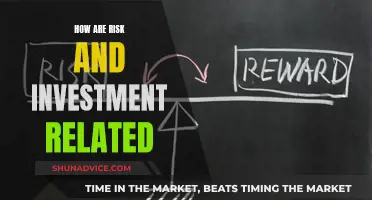
When planned savings exceed planned investments, the economy experiences a situation where expenditure on purchasing goods is lower than what producers anticipated. This results in an unplanned accumulation of inventories of unsold goods, leading to a decrease in aggregate demand (AD) compared to aggregate supply (AS). Producers respond by reducing production and employment, which, in turn, causes a fall in national income. As a result, planned savings start to decrease until they align with planned investments, allowing the economy to achieve an equilibrium level of national income. This equilibrium is reached when the inventory levels are adjusted to meet the desired level, prompting producers to expand output, leading to increased income and, consequently, increased planned savings and investments.
What You'll Learn

Inventories of unsold goods will increase
When savings exceed planned investment, it indicates that consumers are purchasing fewer goods than producers expected. This results in an unplanned accumulation of inventories of unsold goods. Consequently, producers will adjust by cutting down on employment and producing less, which leads to a decrease in national income. As a result, planned savings will start to fall until they become equal to planned investment, bringing the economy to an equilibrium level of national income.
This situation of excess savings over investment can lead to a ripple effect of consequences. Firstly, the rise in inventories of unsold goods can cause logistical issues for businesses. They may need to rent additional storage space or incur costs associated with storing perishable goods. This can put a strain on cash flow and force businesses to reallocate resources that could have been invested in growth or research and development.
Secondly, the decrease in production can have a negative impact on the labour market. To reduce output, firms may lay off workers, leading to an increase in unemployment. This can further contribute to the decline in national income as unemployed individuals tend to consume less, perpetuating the cycle.
Moreover, the accumulation of unsold goods can lead to a decrease in prices. Businesses may resort to discounting their products to clear inventory, which can lead to a deflationary spiral. This can be detrimental to the economy as consumers may postpone purchases, anticipating lower prices in the future. Deflation can also increase the real value of debt, making it more difficult for borrowers to repay their loans.
Finally, the excess savings that are not channelled into investment can lead to a search for alternative investment opportunities. This can result in an increase in asset prices, such as stocks or real estate. While this may benefit those who own these assets, it can also lead to the formation of economic bubbles, which could eventually burst and cause financial instability.
Savings vs. Investments: What's the Difference?
You may want to see also

Producers will cut down on employment
When planned savings exceed planned investment, it indicates that expenditure on purchasing goods is less than what producers expected. This results in an unplanned surplus of inventories of unsold stock. Consequently, aggregate demand (AD) falls short of aggregate supply (AS).
To address this imbalance, producers will reduce their output and cut down on employment. Lowering production levels helps clear the unwanted increase in inventory. However, this decision to produce less leads to a decrease in national income. As national income falls, planned savings also start to decline. This process continues until planned savings become equal to planned investment, bringing the economy to an equilibrium level of national income.
The decision to cut down on employment is a direct response to the reduction in output. With less production, fewer workers are needed, leading to layoffs or reduced hiring. This decrease in employment can have significant social and economic implications, including increased unemployment rates and reduced consumer spending power.
It's important to note that this scenario assumes a closed economy without government intervention or external trade influences. In reality, various factors can influence the economy, and governments often implement policies to mitigate the negative effects of such situations.
Additionally, the specific impact on employment levels can vary depending on the industry, labour market conditions, and the overall health of the economy. Producers may also explore alternative cost-cutting measures before resorting to layoffs. However, in a scenario where planned savings consistently exceed planned investment, reducing employment becomes a likely outcome as producers strive to restore equilibrium.
Investing in New York's 529: A College Savings Guide
You may want to see also

National income will fall
When planned savings exceed planned investments, the economy will adjust to achieve an equilibrium level of national income. This process involves several steps that lead to a reduction in national income:
Firstly, it indicates that expenditure on purchasing goods is less than what producers expected. This results in an unplanned accumulation of inventories of unsold stock. Consequently, aggregate demand (AD) falls short of aggregate supply (AS), leading to a situation where producers have to cut down on employment and produce less.
The reduction in output leads to a decrease in national income. As national income falls, planned savings will also start to fall until they become equal to planned investment. This dynamic continues until the economy achieves an equilibrium level of national income, where the desired level of inventory is met.
The relationship between savings, investment, and income is complex and dynamic. The adjustments made by producers to manage inventories and the subsequent impact on output and income highlight the interconnectedness of various economic factors.
It is important to note that while national income may initially fall when savings exceed investment, the economy has self-correcting mechanisms that work towards restoring balance, ultimately achieving an equilibrium level of national income. This equilibrium state ensures that the economy functions efficiently, with supply matching demand and resources being optimally utilised.
ETFs: Smart Short-Term Investment Strategy for Savings?
You may want to see also

Planned savings will fall
When planned savings exceed planned investment, the economy experiences a decrease in planned inventory levels, falling below the desired amount. This situation arises when actual consumption in the economy is lower than anticipated, resulting in an accumulation of inventories or unsold goods.
To address this imbalance, producers take corrective actions to restore equilibrium. They expand output, leading to increased production and income. This rise in income contributes to an increase in planned investment, which, in turn, leads to a subsequent rise in planned savings. As a result, the economy achieves equilibrium in terms of national income.
However, in the short term, an increase in planned savings compared to planned investment can lead to a reduction in national income. This occurs because the unplanned addition to inventories of unsold stock causes aggregate demand (AD) to fall short of aggregate supply (AS). Producers respond by cutting down on employment and reducing production, which, in turn, lowers national income.
As the income falls, planned savings start to decrease until they eventually align with planned investment. At this point, the economy reaches an equilibrium level of national income, where the savings match the investment. This dynamic illustrates the intricate relationship between savings, investment, and their impact on economic equilibrium.
Investing While Saving for a Home: Wise or Risky?
You may want to see also

Economy achieves equilibrium
When planned savings exceed planned investment, the economy is not in equilibrium. This is because expenditure on buying goods is less than what producers expected, resulting in an unplanned accumulation of inventories of unsold stock. Consequently, aggregate demand (AD) falls short of aggregate supply (AS).
To address this imbalance, producers will reduce their output and cut down on employment, leading to a decrease in national income. As a result, planned savings will start to fall until they become equal to planned investment, bringing the economy back into equilibrium. This equilibrium is achieved when the desired level of inventory matches the actual level.
In this scenario, the economy will experience a decrease in national income. This is due to the reduction in output and employment by producers to clear the excess inventory. As national income falls, planned savings will also decrease until they align with planned investment.
To illustrate this, consider a simple equation representing the equilibrium condition:
Desired Inventory Level = Actual Inventory Level
When planned savings are greater than planned investment, it indicates that consumption in the economy is lower than expected, resulting in an excess of desired inventory over the actual inventory. To restore equilibrium, producers adjust their output and employment levels, impacting national income and planned savings.
It's important to note that this dynamic demonstrates the inherent stability-seeking nature of economic systems. The adjustments made by producers to align inventory levels help to mitigate the initial imbalance and restore equilibrium in the economy.
Graph Savings: A Smart Investment Strategy?
You may want to see also
Frequently asked questions
Inventories of unsold goods will increase, leading to an unplanned addition of stock.
It indicates that expenditure on buying goods is less than what producers expected, resulting in a fall in national income.
Producers will cut down on employment and produce less, causing planned savings to fall until they equal planned investment.







